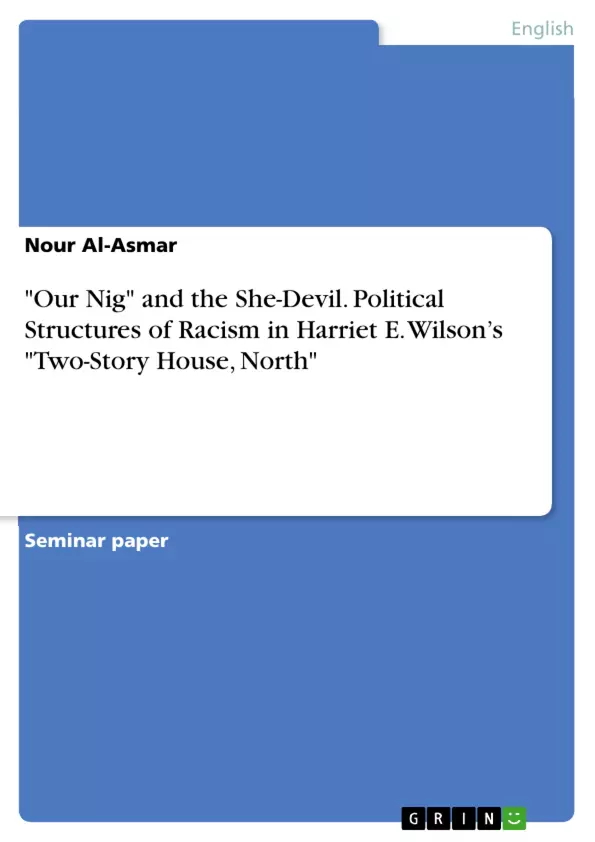This paper seeks to deconstruct structures of racism based on white female power.
Harriet E.Wilson’s “Our Nig: Sketches from the Life of a Free Black, in a Two-Story White House, North. Showing that Slavery's Shadows Fall Even There” achieved historical significance as it is considered to be the first novel published by an African American woman in the United States. Published in 1859, it tells the life story of Frado, a free mulatto who is abandoned by her mother to the white Bellmont’s house, where she is enslaved by the "she -devil” Mrs. Bellmont
In order to understand the racial ideology which Wilson exposes in "Our Nig", the author will first outline the historical and social -political landscape in 19th century North America, which is known to be abolitionist in contrast to the South and secondly put Wilson’s work in a literary context.
Subsequently, she will examine the white middle -class ideology as a structure of power, which allows white women to exert power and authority over black women in the domestic sphere. To achieve this, I will deconstruct the terms Femininity and Domesticity.
Table of Contents
- Introduction
- Antislavery politics in antebellum America: Historical and literary context of Our Nig
- Deconstruction of 19th century Femininity and 'Domesticity'
- Family and 'True Womanhood'
- Racism and abuse in domestic setting
- Frado's resistance against her white female oppressor.
- Domesticity as an allegory of the nation….……………………..
- Conclusion
- Resources
Objectives and Key Themes
This paper examines the structures of racism in Harriet E. Wilson's "Our Nig" through the lens of white female power, focusing on the novel's historical and literary context and its deconstruction of 19th century femininity and domesticity.
- The historical and socio-political landscape of 19th-century America, particularly the abolitionist movement and the role of slavery.
- The ideology of white middle-class femininity and its impact on the lives of black women, particularly within the domestic sphere.
- The concept of "domesticity" as a structure of power and control, with particular attention to the relationship between Frado and Mrs. Bellmont.
- The use of domesticity as an allegory for the larger political and social issues of the time.
- The significance of Harriet E. Wilson's "Our Nig" as a pioneering work of African American literature.
Chapter Summaries
The introduction provides an overview of the paper's focus and its objective to explore the structures of racism in Harriet E. Wilson's "Our Nig" through the lens of white female power. The paper aims to deconstruct the historical and literary context of the novel, examining the ideology of white middle-class femininity and its role in the domestic sphere. It will analyze the dynamics of power between Frado and Mrs. Bellmont and explore how domesticity functions as an allegory for the wider socio-political landscape of 19th-century America. The chapter also discusses the historical significance of "Our Nig" as the first novel published by an African American woman in the United States.
The second chapter delves into the historical and literary context of "Our Nig" by providing a detailed account of the development of slavery in America and the rise of the abolitionist movement. It highlights the role of slavery in the agricultural economy of the South, contrasting it with the relatively insignificant role it played in the North. The chapter further explores the socio-political tensions between the North and the South, culminating in the outbreak of the Civil War and the eventual abolition of slavery with the ratification of the Thirteenth Amendment in 1865.
The third chapter delves into the deconstruction of 19th century femininity and "domesticity" by examining the rise of the white middle class in the United States during the Second Great Awakening and the Industrial Revolution. It explores how the changing social and economic landscape led to the separation of gender roles, with men taking on public roles and women confined to the domestic sphere. The chapter then examines the ideology of "True Womanhood" and its four key characteristics: piety, purity, domesticity, and submissiveness.
Keywords
Key terms and concepts explored in this paper include: "Our Nig," Harriet E. Wilson, antebellum America, slavery, abolitionism, white female power, domesticity, femininity, "True Womanhood," racism, oppression, allegory, and African American literature.
- Quote paper
- Nour Al-Asmar (Author), 2018, "Our Nig" and the She-Devil. Political Structures of Racism in Harriet E. Wilson’s "Two-Story House, North", Munich, GRIN Verlag, https://www.grin.com/document/539277



